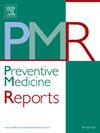Analysis of the relationship between abdominal aortic calcification and frailty in the middle-aged and older US population
IF 2.4
3区 医学
Q2 PUBLIC, ENVIRONMENTAL & OCCUPATIONAL HEALTH
引用次数: 0
Abstract
Background and Objective: Abdominal aortic calcification (AAC) is a marker of cardiovascular disease and is associated with increased mortality in middle-aged and older populations. However, its relationship with frailty remains unclear.
Methods: Data were obtained from the 2013–2014 National Health and Nutrition Examination Survey. AAC was quantified using the Kauppila scoring system based on dual-energy X-ray absorptiometry. Frailty was assessed using the frailty index. Multivariable logistic regression models examined the association between AAC and frailty.
Results: A total of 2987 adults aged ≥40 years were included. Compared to individuals with an AAC-8 score of 0, low-risk (AAC-8 score = 1–2; OR: 1.24; 95 % CI, 1.00–1.53) and high-risk AAC (AAC-8 score ≥ 3; OR: 1.83; 95 % CI, 1.03–3.23) were associated with higher odds of frailty. Similarly, mild to moderate AAC (0 < AAC-24 score ≤ 6; OR: 1.26; 95 % CI, 1.03–1.54) and severe AAC (AAC-24 score > 6; OR: 1.79; 95 % CI, 1.07–2.99) showed positive associations with frailty.
Conclusions: Among middle-aged and older populations in the United States, there exists a positive correlation between AAC and frailty. Our findings suggest that the AAC score holds promise as a valuable tool for the early identification of frailty.
求助全文
约1分钟内获得全文
求助全文
来源期刊

Preventive Medicine Reports
Medicine-Public Health, Environmental and Occupational Health
CiteScore
3.90
自引率
0.00%
发文量
353
 求助内容:
求助内容: 应助结果提醒方式:
应助结果提醒方式:


